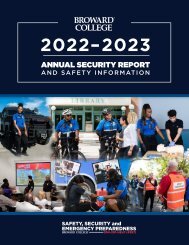bc-annual-security-report-20-21
You also want an ePaper? Increase the reach of your titles
YUMPU automatically turns print PDFs into web optimized ePapers that Google loves.
SHOTS FIRED ON CAMPUS (STUDENTS/<br />
FACULTY/STAFF)<br />
DSSEP offers instructional training and video<br />
curriculum concentrating on empowering people<br />
with the knowledge and strategies for preventing<br />
and responding to active shooter situations. This<br />
video is also available for self-paced viewing for<br />
students (through MyBC) and faculty/staff (through<br />
Broward Connect).<br />
STAYING SAFE ON CAMPUS – GENERAL<br />
SAFETY (STUDENTS/FACULTY/STAFF)<br />
DSSEP provides on-going training to students,<br />
faculty, and staff. The Staying Safe on Campus<br />
program encompasses general safety tips on topics<br />
such as community safety (situational awareness),<br />
creating a safe environment (car, classroom, parking<br />
lots, common areas, and isolated areas), <strong>report</strong>ing<br />
incidents, sexual assault/violence, and state of<br />
preparedness (understanding how to respond in<br />
times of emergencies).<br />
FIRE SAFETY (FACULTY/STAFF)<br />
One in three persons will have an experience with fire<br />
during his or her lifetime. Therefore, fire extinguisher<br />
training is available to faculty and staff. This<br />
training brings the feel of real life extinguishment<br />
in a controlled environment. Hands-on training<br />
teaches controlled reactions that give the ability to<br />
respond and make decisions quickly during a real<br />
emergency evacuation.<br />
1. Are you sure you know what to do in case of a fire?<br />
2. Do you know when not to use an extinguisher?<br />
3. Do you know how to use an extinguisher?<br />
Attendees learn some basic tips to reduce the<br />
likelihood of a fire at work and at home. One of the<br />
training aids involves an indoor simulation system<br />
that projects a fire on a screen utilizing laser fire<br />
extinguishers for those college office occupants who<br />
don’t have the luxury of leaving the building for a<br />
training session. Also, we combine the procedural<br />
steps of evacuation should the need occur to use a<br />
fire extinguisher upon egress. The additional station<br />
includes a pull station, strobe light, smoke detector,<br />
annunciator, and an interactive 911 phone that allows<br />
participants to practice responding to an emergency<br />
from the moment a fire is noticed.<br />
LEARN NOT TO BURN (STUDENTS/<br />
FACULTY/STAFF)<br />
This course sheds light on the importance of<br />
emergency responses. The fire alarm system gives<br />
individuals time to get out. Notification devices,<br />
such as strobe lights and audible horns provide an<br />
alert to occupants of the need to evacuate or act<br />
in the event of other emergencies. Outcomes for<br />
participants include:<br />
• Addressing, not questioning the fire alarm<br />
detection systems.<br />
• Closing doors for containment.<br />
• Evacuation utilizing both a primary and<br />
a secondary means of egress.<br />
• Learning where individuals should meet after<br />
evacuating a building, and why remaining there<br />
is so important.<br />
• Notifying emergency responders of persons<br />
that might be still inside needing assistance.<br />
WORK PLACE SAFETY (FACULTY/STAFF)<br />
Generalized workplace safety training is held<br />
to ensure that employees understand general<br />
coordination to accompany safety and emergency<br />
policies and procedures. The purpose of this is to<br />
improve health and safety, prevent injuries, and<br />
improve productivity. In addition, the training<br />
includes training related to hazards of jobs, retraining<br />
as required by standards, or, when equipment or<br />
processes change and, when employees change jobs<br />
or return from long absences. Although the office<br />
is not typically considered hazardous, a surprising<br />
number of accidents and injuries occur there. The<br />
common types of hazards and concerns include<br />
falling objects; slips, trips and falls; fires; electrical<br />
shock; exposure to hazardous chemicals; and back<br />
injuries. Good housekeeping, common safety sense<br />
and paying attention to one’s surroundings are<br />
usually adequate to control hazards.<br />
LIFEGUARD/CPR/AED<br />
Lifeguard certification classes are offered at Tigertail Lake<br />
Recreational Center. CPR/AED classes are offered for<br />
employees through the Center for Teaching Excellence<br />
and Learning.<br />
NATIONAL CAMPUS SAFETY AWARENESS<br />
MONTH CAMPAIGN<br />
Held in September in honor of National Campus Safety<br />
Awareness Month, DSSEP works collaboratively with<br />
various departments and organizations to arrange a<br />
Campus Safety Day on each of the main campuses as<br />
well as at the Miramar West Center where students,<br />
faculty, and staff are offered an interactive experience<br />
that promotes safety, raises awareness, and affords<br />
training through partnerships with Student Life and<br />
both internal and external vendors.<br />
IF YOU SEE SOMETHING,<br />
SAY SOMETHING CAMPAIGN<br />
DSSEP has worked collaboratively with the<br />
Department of Homeland Security to join efforts<br />
in their national campaign known as “If You See<br />
Something, Say Something.” This element emphasizes<br />
the importance of community involvement and<br />
the role of individuals as members of the College<br />
community.<br />
16 Broward College

















